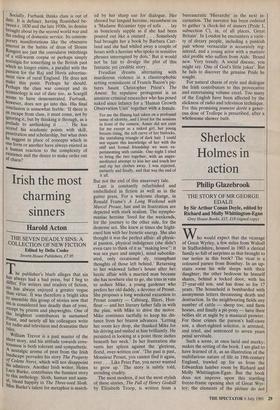Sherlock Holmes in action
Philip Glazebrook
THE STORY OF MR GEORGE EDALJI by Sir Arthur Conan Doyle, edited by Richard and Molly Whittington-Egan
Grey House Books, £15, £18 (signed copy)
Who would expect that the vicarage of Great Wyrley, a few miles from Walsall in Staffordshire, housed in 1903 a clerical family so full of surprises as that brought to our notice in this book? The vicar is a coloured parsee from Bombay. In an up- stairs room his wife sleeps with their daughter; the other bedroom he himself shares, behind a locked door, with his 27-year-old son, and has done so for 17 years. The household is bombarded with anonymous letters threatening death and destruction. In the neighbouring fields any number of cattle — sheep too, and farm horses, and finally a pit-pony — have their bellies slit at night by a maniacal prowler. For these crimes the parson's half-caste son, a short-sighted solicitor, is arrested, and tried, and sentenced to seven years penal servitude.
Such a scene, at once lurid and murky, makes the setting of the book. I am glad to have learned of it, as an illustration of the multifarious nature of life in 19th-century England, trawled up for us from the Edwardian lumber room by Richard and Molly Whittington-Egan. But the book does not improve upon this startling freeze-frame opening shot of Great Wyr- ley; the elements of the picture do not come to life, nor do the events resolve themselves into a story.
The cattle-maimings and poison-pen let- ters did not cease with the arrest of George Edalji, the parson's son. A campaign by a Mr Yelverton, and articles in the papers, and a petition signed by 10,000 names, procured his release on licence in 1906, after three years in gaol. At this point Sir Arthur Conan Doyle interested himself in the case. His first wife had just died and he was waiting a decent interval, creative work in abeyance, oefore marrying his second. Instead of sending out Sherlock Holmes to right imaginary wrongs, he determined upon setting out himself to right an injury to the real world. A biographer in the Edel mould, anxious to relate the creative writer's inner life to his outer, would no doubt fall upon this incident greedily, and cook it up into an unsavoury meal.
Conan Doyle's objective was to win for Edalji a free pardon, compensation, and reinstatement on the Roll of Solicitors. Two articles in the Daily Telegraph in January 1907 sought to prove Edalji's innocence of the pit-pony slaying, further letters to the same newspaper hoped to clear him of having written the poison-pen threats, and a statement to the Home Office tried to attach the blame for both crimes to a rascally sailor, Royden Sharp. It is these newspaper letters and articles which form the text of the book.
The editors describe what they have produced as a 'lost' work of Conan Doyle.
Material published in a newspaper, and twice republished as a pamphlet, may honestly be described as 'forgotten', but to call it 'lost' is to attribute by inference a high value to every trifle from its author's pen — as in The Lost Stradivarus — which brings to mind the auctioneers' hype of trivia from the lumber room, and puts the reader on his guard. Let the editors de- scribe it as 'lost' if they will; what the reader is concerned with is whether it was worth finding.
Well, we do see Conan Doyle trying to apply Sherlock Holmes's ludicrous 'methods' to a real case. There is, for instance, a vast amount of inferring and deducing over the question of if and how horse hairs came upon Edalji's coat, which serves to remind us of Doyle's skill as a creative writer when, in the Holmes stor- ies, he persuades us to suspend our dis- belief whilst the Great Detective spins out some similarly absurd rigmarole with its pretence of 'logic' and 'deduction'. And we may catch, too, occasionally, the authentic note of the Holmes stories: 'It is a tale which makes a man hot with indignation as he reads it' — do we not hear Holmes's voice exclaiming in these words to Dr Watson before plunging into a case, and do we not make ourselves comfortable in our chairs in pleasurable anticipation of an ingenious story?
This, though, is not that story. After its promising opening shot of Great Wyrley vicarage there follows no development, no very satisfactory conclusion. If the opaque, goggling figure of Edalji had come alive for us on the page by some human stroke, we might have lively feelings for him, but he does not. If Doyle's defence of the poor fellow, or his attack upon Royden Sharp, are to be of forensic interest to us, we should need to have before us the case put by the other side, but we do not. Lacking these, it must be confessed that the 'heat of indignation' which inspired Doyle has rather gone out of a case of cattle-maiming in Staffordshire 70 years ago.
The trial evidence — Royden Sharp's defence — scenes of clerical life within Great Wyrley vicarage — these are the truly 'lost' documents in the case, whose discovery might reconcile the reader to paying £15 for this book; and even to paying the extra £3 at which the editors value their signatures.



















































 Previous page
Previous page